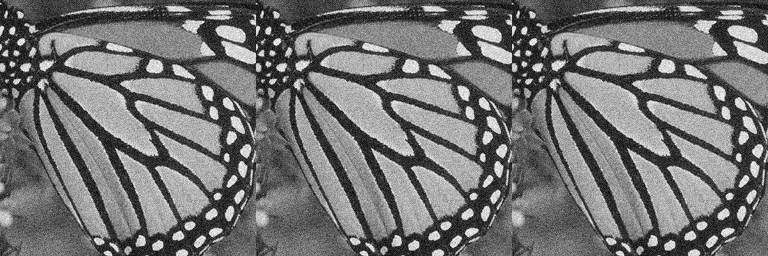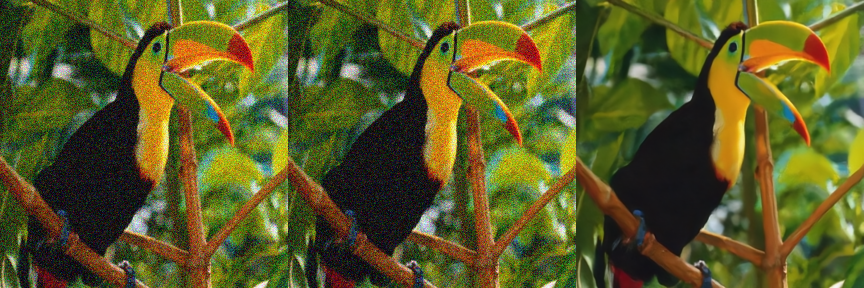Comments (23)
No. Basically, you should know noise models before training because training data should be created through degrading clean images by the noise models.
If you train a model using several types of noise models, you might be able to denoise a noise image even if the noise type of the image is unknown, as long as the noise type is one of the noise types used in training.
from noise2noise.
think you very much
from noise2noise.
Another question,how can i know the type of noise i want to deal with?
Actually,the method proposed by the paper can not denoise any image,right?
from noise2noise.
I mean that ,i have lots of images,some of them are not very clear,and i want to denoise them。
but i don‘t know how to deal with it,can you give me a suggestion?
thanks a lot!
from noise2noise.
The answer is the same as the previous comment.
You should deeply check the noisy images, group them into several types, implement the noise models to train a denoising model, and then train a model.
from noise2noise.
I believe even though you don't know the noise type, you can use the method to denoise if you observer the same scene twice and get two independent noise image.
from noise2noise.
I believe even though you don't know the noise type, you can use the method to denoise if you observer the same scene twice and get two independent noise image.
Theoretically yes. But I'm afraid that it is difficult to get two independent noise images in real applications (e.g. "i have lots of images,some of them are not very clear,and i want to denoise them" as @zjz5250 mentioned).
from noise2noise.
@yu4u how about capture twice, if you have the capture device.
from noise2noise.
If there is a capture device, one can create a dataset for training a denoising model dedicated to the device; it's exactly the expected application of the original paper.
from noise2noise.
I want to know whether there is model trained.If I have a picture,I can load the model and denoise the picture instead of training by myself.
from noise2noise.
You can find it in README.
from noise2noise.
You can find it in README.
I read REANME yesterday. Your code can product some nosied images and denosied images but this is a process you made.But I have a picture which there is gaussian noise in true life,I config the command and download your trained weights but I don't have seen results.
from noise2noise.
Please clarify what you did in command line level.
from noise2noise.
Please clarify what you did in command line level.
If I analysis the nosied data's distribution parameters ,when I use your weights to predict a noise images to clean image,is it neccessary to config parameters in command line?
from noise2noise.
I guess that my images is gray that it doesn't work.If I want to denois images I need to train weights by myself what do you think?
from noise2noise.
I can't give meaningful comments without knowing exactly what you did (commands, error logs ...).
What do you mean by it doesn't work?
Any script finished with error? Results were strange?
Regarding gray images, it is possible to treat gray images as color images with three channels by changing
image = cv2.imread(str(image_path))
to
image = cv2.imread(str(image_path), 1)
from noise2noise.
If I use a clean image, then add noise by your "get_noise_model", it works very well. But if I load a noisy image with Gaussian noise, then set --test_noise_model to clean. It doesn't work at all. It means the Gaussian noise is not reduced at all. It looks like this code treats the noisy image as a clean one. I thought several reasons but it still doesn't work. Could you help me check the reason when you are convenient?
from noise2noise.
Please describe what is the problem (and what you want to do) and how to reproduce the problem.
What did you mean by "doesn't work".
from noise2noise.
If input (the test image) is a clean image, then add noise by your "get_noise_model", it works very well. But if input is a noisy image (which is already contaminated with Gaussian noise), so we don't need to add noise by your "get_noise_model" and set "test_noise_model "to" clean". The Gaussian noise of the input noisy image won't be reduced. The output is exactly the same as the input.
from noise2noise.
Could you provide the test image and the command line you executed?
from noise2noise.
My test image is selected from you test dataset, such as bridge. I found that if the input noisy image (which is already contaminated with Gaussian noise) is a gray one, the noise can not be reduced from you test code (even using image = cv2.imread(str(image_path), 1)) . If the input noisy image is a color one, it works well. You can check for that
from noise2noise.
Could you provide the test image that can not be denoised?
I could denoise the bridge image with Gaussian noise.
from noise2noise.
Hi! @yu4u as you can see below
I add noise to Set5 images with ImageJ and let one of them as a grayscale image.
By using ImageJ (Process > Noise > Add Noise) then (Image > Type > 8-bit).
I got saved image as the left one.
Then excute denoise process "test_model.py"
with weight "weights.056-66.803-30.57923_gauss_clean.hdf5"
and argument "--test_noise_model clean"
Compare to the RGB (without converting to 8-bit) image as below
It seems it can't deal with already noised Grayscale image, in other words,
not only the image but even the "noise" is also gray.
Do you have any idea whit this issue?
Thanks!
from noise2noise.
Related Issues (20)
- Already have Input-Output Noisy Pairs HOT 1
- Hi ! Any kinds of pictures can be fit for your net? HOT 12
- How do I get this to work and can it work for what I want it to? HOT 8
- How do clean document scans with this? HOT 1
- How do I use the trained model file to remove noise from my photos? HOT 1
- How to modify random text noise for custom image noise? HOT 1
- can this use in point cloud denoising? HOT 1
- I want to use our own noisy data to train the model HOT 3
- Tensorflow error HOT 5
- run error
- AttributeError: module 'tensorflow' has no attribute 'log' HOT 2
- Can not generate the weight file when use my train images HOT 4
- remove other watermarking HOT 2
- Deleting dataset causes error (Google Colab) HOT 2
- I have GPU GeForce GTX 1050 and 32GB RAM but still issuse of OOM HOT 2
- one-dimensional data instead of pictures HOT 1
- There's some problem in the training process
- EEE students, Beginners in the field need assistance
- loss nan or inf HOT 7
- > @HongChow
Recommend Projects
-
 React
React
A declarative, efficient, and flexible JavaScript library for building user interfaces.
-
Vue.js
🖖 Vue.js is a progressive, incrementally-adoptable JavaScript framework for building UI on the web.
-
 Typescript
Typescript
TypeScript is a superset of JavaScript that compiles to clean JavaScript output.
-
TensorFlow
An Open Source Machine Learning Framework for Everyone
-
Django
The Web framework for perfectionists with deadlines.
-
Laravel
A PHP framework for web artisans
-
D3
Bring data to life with SVG, Canvas and HTML. 📊📈🎉
-
Recommend Topics
-
javascript
JavaScript (JS) is a lightweight interpreted programming language with first-class functions.
-
web
Some thing interesting about web. New door for the world.
-
server
A server is a program made to process requests and deliver data to clients.
-
Machine learning
Machine learning is a way of modeling and interpreting data that allows a piece of software to respond intelligently.
-
Visualization
Some thing interesting about visualization, use data art
-
Game
Some thing interesting about game, make everyone happy.
Recommend Org
-
Facebook
We are working to build community through open source technology. NB: members must have two-factor auth.
-
Microsoft
Open source projects and samples from Microsoft.
-
Google
Google ❤️ Open Source for everyone.
-
Alibaba
Alibaba Open Source for everyone
-
D3
Data-Driven Documents codes.
-
Tencent
China tencent open source team.




from noise2noise.